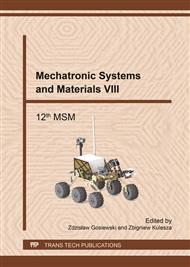[1]
F. J. Vertucci, Root canal morphology and its relationship to endodontic procedures, Endod. Topics, vol. 10, p.3–29, (2005).
DOI: 10.1111/j.1601-1546.2005.00129.x
Google Scholar
[2]
Kasmer Kerekes, Leif Tronstad, Long-term Results of Endodontic Treatment Performed with a Standardized Technique, Journal of Endodontics, vol. 5, p.83–90, (1979).
DOI: 10.1016/s0099-2399(79)80154-5
Google Scholar
[3]
Toru Matsumoto, Takashi Nagai, Kazuhiko Ida, Masato Ito, Yasuo Kawai, Naoki Horiba, Ryo Sato, Hiroshi Nakamura, DDS, PhD1 Factors affecting successful prognosis of root canal treatment, Journal of Endodontics, vol. 13, p.239–242, (1987).
DOI: 10.1016/s0099-2399(87)80098-5
Google Scholar
[4]
Koko Kojima, Kyoko Inamoto, Kumiko Nagamatsu, Akiko Hara, Kazuhiko Nakata, Ichizo Morita, Haruo Nakagaki, Hiroshi Nakamura, Root canal morphology and its relationship to endodontic procedures, Oral Surgery, Oral Medicine, Oral Pathology, Oral Radiology, and Endodontology, vol. 97, pp.95-99, (2004).
DOI: 10.1016/j.tripleo.2003.07.006
Google Scholar
[5]
F. J. Vertucci, Root canal anatomy of the human permanent teeth, Oral. Surg. Oral. Med. Oral. Pathol. Oral. Radiol., vol. 58, p.589–599, (1984).
DOI: 10.1016/0030-4220(84)90085-9
Google Scholar
[6]
S. W. Schneider, A comparison of canal preparations in straight and curved root canals, Oral Surg, Oral Med, Oral Pathol. vol. 32, p.271–5, (1971).
DOI: 10.1016/0030-4220(71)90230-1
Google Scholar
[7]
D. Green, Double canals in single roots, Oral Surg, Oral Med, Oral Pathol. vol. 35, p.689–696, (1973).
DOI: 10.1016/0030-4220(73)90037-6
Google Scholar
[8]
T. Von Arx, Frequency and type of canal isthmuses in first molars detected by endoscopic inspection during periradicular surgery, Int. Endod. J., vol. 38, p.160–168, (2005).
DOI: 10.1111/j.1365-2591.2004.00915.x
Google Scholar
[9]
M. D. Fabbro and S. Taschieri, Endodontic therapy using magnification devices: A systematic review, J. Endodont., vol. 38, p.269–275, (2010).
DOI: 10.1016/j.jdent.2010.01.008
Google Scholar
[10]
A. Dawood, S. Patel, and J. Brown, Cone beam CT in dental practice, Br. Dent. J., vol. 207, p.23–28, (2009).
DOI: 10.1038/sj.bdj.2009.560
Google Scholar
[11]
T. P. Cotton, T. M. Geisler, D. T. Holden, S. A. Schwartz, W. G. Schindler, Endodontic Applications of Cone-Beam Volumetric Tomography, J. Endodont., vol. 33, p.1121–1132, (2007).
DOI: 10.1016/j.joen.2007.06.011
Google Scholar
[12]
C. Estrela, M. R. Bueno, C. R. Leles, B. Azevedo, and J. R. Azevedo, Accuracy of cone beam computed tomography and panoramic and periapical radiography for detection of apical periodontitis, J. Endodont., vol. 34, p.273–279, (2008).
DOI: 10.1016/j.joen.2007.11.023
Google Scholar
[13]
A. K. Suomalainen, A Salo, S. Robinson, and J. S. Peltola, The 3DX multi image micro-CT device in clinical dental practice, Dentomaxillofac. Rad., vol. 36, p.80–85, (2007).
DOI: 10.1259/dmfr/30358216
Google Scholar
[14]
K. Nakata, M. Naitoh, M. Izumi, K. Inamoto, E. Ariji, H. Nakamura, Effectiveness of dental computed tomography in diagnostic imaging of periradicular lesion of each root of a multirooted tooth: a case report, J. Endodont., vol. 32, p.583–587, (2006).
DOI: 10.1016/j.joen.2005.09.004
Google Scholar
[15]
R. V. Stambaugh, G. Myers, W. Ebling, B. Beckman, and K. Stambaugh, Endoscopic visualization of the submarginal gingiva dental sulcus and tooth root surfaces, J. Periodontol, vol. 73, p.374–82, (2002).
DOI: 10.1902/jop.2002.73.4.374
Google Scholar
[16]
G. W. Marshall Jr., M. R. Lipsey, M.A. Heuer, C. Kot, R. Smarz, and M. Epstein, An endodontic fiber optic endoscope for viewing instrumented root canals, J. Endodont., vol. 7, p.85–88, (1981).
DOI: 10.1016/s0099-2399(81)80248-8
Google Scholar
[17]
S. Yoshii, Y. Zhang, S. Ikezawa, C. Kitamura, T. Nishihara, and T. Ueda, Study of endoscopy for dental treatment, Int. J. Smart Sensing Intell. Syst., vol. 6, no. 1, p.1–17, (2013).
DOI: 10.21307/ijssis-2017-525
Google Scholar
[18]
M. Fujimoto, S. Yoshii, S. Ikezawa, T. Ueda, C. Kitamura, Development of dental endoscope, 9th International Conference on Sensing Technology, p.551–556, (2015).
DOI: 10.1109/icsenst.2015.7438451
Google Scholar
[19]
M. Fujimoto, S. Yoshii, S. Ikezawa, T. Ueda, C. Kitamura, Fabrication of Two Different Probe Architectures for Ultra-Compact Image Sensors for Root Canal Observations, IEEE Sensors Jouranl, vol. 16, issue no. 13, (2016).
DOI: 10.1109/jsen.2016.2562118
Google Scholar
[20]
K-C. Huang, P. R. Wesselink, The pulse exciation of UV LED source for fluorescence detection, 2011 IEEE Instrumentation and Measurement Technology Conference (I2MTC), p.1–4, (2011).
DOI: 10.1109/imtc.2011.5944032
Google Scholar
[21]
T. Hopp, P. Baltzer, M. Dietzel, W. A. Kaiser, N. V. Ruiter, 2D/3D image fusion of X-ray mammograms with breast MRI: visualizing dynamic contrast enhancement in mammograms, Int. J. Comput. Assist. Radiol. Surg., vol. 7, p.339–348, (2012).
DOI: 10.1007/s11548-011-0623-z
Google Scholar
[22]
A. S. Abdelrehim, A. A. Farag, A. M. Shalaby, M. T. El-Melegy, 2D-PCA shape models: application to 3D reconstruction of the human teeth from a single image, Medical Computer Vision. Large Data in Medical Imaging, Lecture Notes in Computer Science, vol. 8331, p.44–52, (2014).
DOI: 10.1007/978-3-319-14104-6_5
Google Scholar
[23]
Y. Hirogaki, T. Sohmura, H. Satoh, J. Takahashi, K. Takada, Complete 3-D reconstruction of dental cast shape using perceptual grouping, Medical Imaging, IEEE Transactions, vol. 20, p.1093–1101, (2001).
DOI: 10.1109/42.959306
Google Scholar


